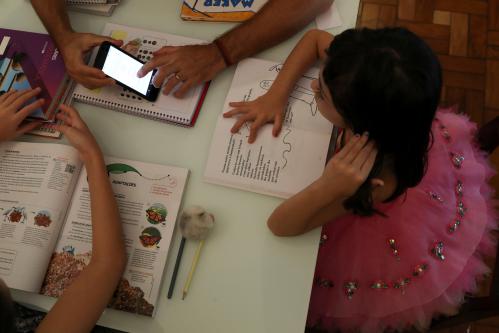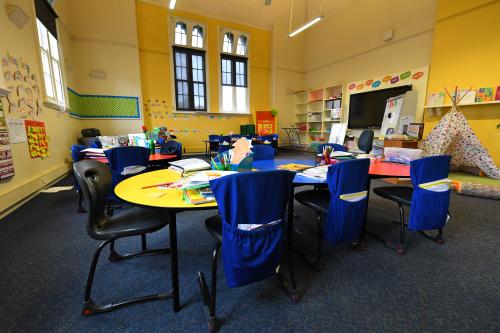This op-ed was originally published by Ed-Surge.
For perhaps the first time in recent memory, parents and teachers may be actively encouraging their children to spend more time on their electronic devices. Online learning has moved to the front stage as 90 percent of high-income countries are using it as the primary means of educational continuity amid the COVID-19 pandemic.
If March will forever be remembered as the month that virtually all the world’s countries closed their school doors, will April be remembered as the month that students around the world embraced the world of online learning?
There is no shortage of optimistic speculation from education experts and innovators that this experience will have a transformative effect on education after the pandemic is over. The hope is that teachers will be more well-versed in the range and use of quality online learning resources, schools will welcome innovation that drives better and more enriched learning experiences, and students will demand more interesting multimedia and multimodal learning experiences.
I certainly hope this will be true. But what if it is not?
There is some evidence that such hope will not materialize, at least if we continue with what we are doing now. Christopher Pommering, founder of Learnlife, a global network dedicated to fostering lifelong learning practices, says many of the 1,000 school leaders across the 60 countries in its network report that both teachers and students are burning out from trying to conduct the traditional school day in an online environment.
“We are being flooded with requests for assistance on how to develop effective and engaging remote learning experiences, especially after the first or second week in which schools try to transfer their normal curriculum to an online format and parents and teachers realize it doesn’t work,” he says.
To understand the major pitfalls of online learning and what we need to do to avoid them, I recently spoke with Richard Culatta, CEO of the International Society for Technology in Education (ISTE). As someone who earned his stripes as a classroom teacher and designer of multiple online courses, and who previously held positions as the chief innovation officer for the state of Rhode Island and director of the Office of Education Technology for the U.S. Department of Education, Richard is a go-to person for exploring the shift we are experiencing in learning today.
As Richard posits, if we aren’t careful to avoid the pitfalls, “it will guarantee that nobody will ever want to do online learning again after coronavirus is over.”
Here are Culatta’s top five pitfalls that could kill online learning—and how to avoid them.
- The content trap
When you look at moving a school online, the first question is often, “What content do we need to make available?” Immediately everybody’s mind goes to uploading chapters of the textbook and worksheets to Google Classroom. People often forget that the learning content is one small fraction of an effective learning experience.
When people fall into the content trap, online learning has all of the materials but none of the heart. Students are just sitting there, clicking “next” through presentations that have been uploaded to an LMS (learning management system). It’s painful to watch. You can see the kids slipping into a coma while they sit there. It teaches kids to hate learning. It teaches them that learning is boring.
To avoid the content trap, it is important to consider all of the critical elements of learning and think about how to design them for a virtual space. For example, what do virtual conversations look like, or virtual art projects?
Or what about digital recess? There are lots of fun ways to do recess in a virtual space. You could certainly do group exercises in front of the computer but, depending on the age of the kids, you could use free apps, some with geotagging, to run around the block and see how far you have gone or do a scavenger hunt in your neighborhood.
The point is: Don’t just upload scanned textbooks and worksheets and think it’s going to be a good learning experience. It’s actually going to be a horrendously boring and painful learning experience. If that’s what we’re going to do, we might question whether it’s better to just not do learning at all.
- The one-size-fits-all trap
When we move to an online environment, we shouldn’t assume that one approach or type of activity will work for all students (and frankly, we shouldn’t assume this in the classroom either). It is easy to create online assignments without remembering that every student has unique needs, interests, and challenges.
Fortunately, it turns out that providing personalized learning experiences is one of the areas where online learning can improve on the classroom experience. Since every kid isn’t sitting in the same classroom at the same time, there is no excuse to not have them working on a variety of different activities that align to their own unique interests and strengths. If a kid is learning math, for example, programs like Dreambox Learning or Zearn can adapt to the needs of each individual learner and share progress with teachers and parents.
This is particularly important for special populations, such as young children, English language learners, or students with physical, emotional, or cognitive challenges. We have Individualized Education Plans (IEP) for a reason, and we can’t forget that when we move online we also need a digital IEP where we create an individual program using the virtual environments.
Fortunately, there are lots of digital tools to facilitate this. For some kids, it could be as simple as installing screen readers or using voice commands. For others, it might mean breaking the content into smaller pieces and having more check-ins. There are a variety of apps, like Newsela, that adapt and adjust the content to a wide variety of English language proficiency. At ISTE, we are launching a new course for teachers around designing online learning with special populations in mind.
- The isolation trap
Teaching and learning online does not mean learning alone. But many people forget that. School provides critical human interactions—a chance to engage with friends, not only on a social level, but also for learning. It also provides the chance for mentorship from an adult. There are a lot of different ways to do that online. In fact, I would argue it may be even easier to do peer collaboration in virtual spaces.
There are a whole bunch of tools that can facilitate collaboration without some of the challenges, like noise, that you run into in the classroom. In the classroom, we limit our social learning experience to other kids in the class. But when you are in a virtual space, that sort of collaboration could be with kids all around the world.
It is also a great way to think about incorporating experts that, frankly, would never come to the school in person. In a virtual space, you can invite a book author, engineer, or a legislator to engage with your students directly. That access to expertise and global peers can make online learning a much more connected environment than the traditional classroom.
- The teaching transfer trap
Another big pitfall is thinking that if you know how to teach in the physical world, all you need to do is just log onto an online tool, and you will be effective at teaching in the virtual world. That is just absolutely not true.
Of course, the basic foundations of learning are the same. But the way you manifest those in a virtual space is very different. For example, if you are trying to assess student learning online, a teacher who does not have experience teaching online might revert to using multiple choice tests or uploading worksheets. In the virtual classroom, there are far more options for assessing learning than there are in the traditional classroom, but no teacher is born knowing how to do this.
While the basic principles of assessing learning remain the same, teachers must learn new approaches for authentic assessment in a virtual space. For example, you might ask them to make their own Khan Academy-style videos explaining how to solve a problem. You could even have other members of the class review the script for accuracy, as a test of their knowledge. Using document histories the teacher can see all of the contributions that different students have made along the way.
But teachers need support to learn skills like authentic online assessment. It is inappropriate to just expect that because a teacher is really good in a physical classroom, that he or she will suddenly just know how to be a good teacher in a virtual classroom. Teachers also should be recognized for the skills they develop in this domain.
- The learning-is-serious trap
For some reason when learning moves to a virtual space, it generally also becomes much more serious. I’ve watched this happen over and over again. A teacher who is funny and engaging in the physical classroom often doesn’t know how to convey that “fun-ness” through virtual tools. When that happens, learning becomes very serious and, honestly, boring.
Fortunately there are many simple ways to make a virtual classroom fun. In virtual classrooms, something as simple as playing music when people sign in to the session can completely change the tone, and signal “this is a fun place, we’re going to learn and it’s going to be fun.” Using video interstitial transitions can both break up the experience and add humor. Creating polls is another way to keep learning fun and can still be related to the topic. If you’re having a math class, posting a silly question like “what is a vampire number?” (yes, that’s a real thing) and seeing what answer students choose can help lighten the experience of being online.
Ultimately, learning online can have many benefits and allow for new ways to engage and challenge students. But only if schools do not fall into these five traps. It’s upon school leaders to ensure that educators are supported and trained to do just that.







Commentary
Op-ed5 traps that will kill online learning (and strategies to avoid them)
May 4, 2020